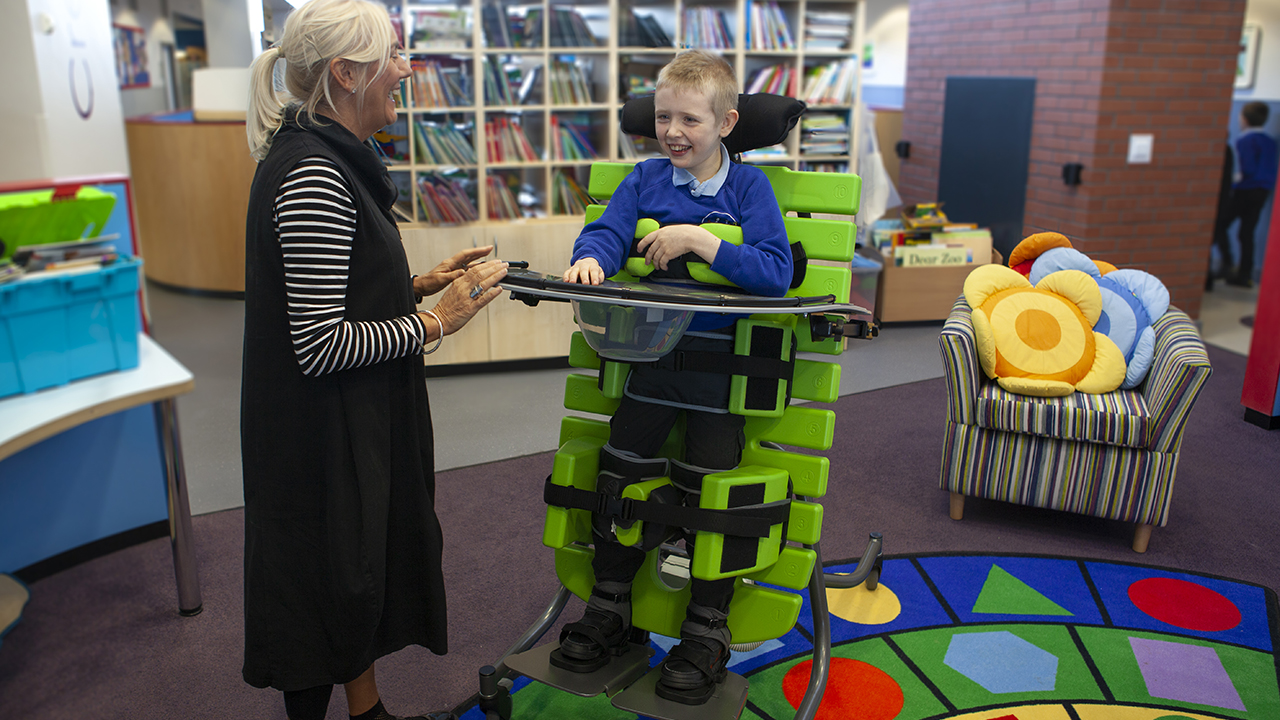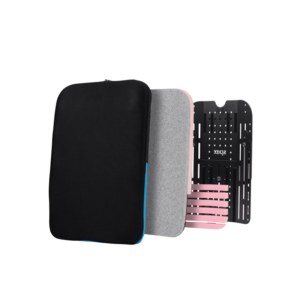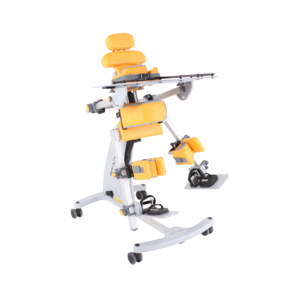Standing is a great addition to a therapeutic and postural management regime for children and adults with complex disabilities. In this blog Richard Harvey, Clinical Training Manager, discusses the countless clinical benefits which affect skeletal health, the muscular system and improving the function of internal organs.
It is well evidenced that standing in an upright position in full extension, weight bearing through the hips, knees and ankles, has a positive effect on bone mineral density for developing children. Ensuring a child is standing by the age of around 12 months can yield better outcomes in bone mineral density and hip development, as shown in a number of studies. When we are born our hip joint (acetabulum) is not formed. It is the process of standing upright, bearing weight through our joints, as well as active movement that helps to develop the hips over time. Once a child reaches the ages of around 6-8 years old their bones become less malleable. Therefore if the acetabulum has not formed it can lead to further complications such as hip dysplasia and subluxation.

In terms of our muscular system, studies have also shown that standing has a positive effect on maintaining hamstring length. A study by Martinsson and Himmelmann involved 97 children who have cerebral palsy with GMFSC 3-5. The control group (the group of children that didn’t receive the same standing intervention) showed signs of tissue adaptation and contracture formation. No children who received the standing intervention developed contractures in the knees or hips for the duration of the study. Each child stood between 30-90 minutes a day, 5 days a week.
Not only is standing a great addition to a robust postural management regime, it can really positively effect a child’s happiness and their engagement. Being at the same height as their peers or siblings can help to develop social skills as well as motor skills. In a class room or play environment, it can create new opportunities for learning and fun to lead to a more active fulfilling life. Being in a new or different posture can also help with body and spatial awareness. This can aid the child in learning more about their environment and surroundings. This is one of the reasons why standing at any age is beneficial and can contribute to a child or adult’s happiness and wellbeing.
The Supine Stander by Jenx is an excellent example of an easy to use, functional and safe standing frame. As it has a solid board, it allows the user to be transferred onto the frame safely without the risk of limbs or a sling getting caught in any equipment. It is also great for infection control as the frame is completely wipeable without any fabrics that have to be removed or washed separately. It is incredibly versatile with a plethora of accessories to accommodate the needs of a variety of different users.
The Supine Stander is available in 3 sizes, and can accommodate users from 9 month – adult, up to 100kg.
- Systematic Review and Evidence-Based Clinical Recommendations for Dosing of Paediatric Supported Standing Programs. (Paleg, Ginny, S et al 2013)
- Effect of weight-bearing in abduction and extension on hip stability in children with cerebral palsy. (Martinsson & Himmelmann, 2011)
- Choosing support equipment in children’s therapy. (Bakewell J 2007)
- Use of prolonged standing for individuals with spinal cord injuries. (Eng JJ, et al 2001)
- Limb contractures in progressive neuromuscular disease and the role of stretching, orthotics, and surgery. (McDonald CM.1998)
- Effects of prolonged muscle stretch on reflex and voluntary muscle activations in children with spastic cerebral palsy. (Tremblay F, et al 1990)
- Factors affecting prescription and implementation of standing-frame programs by school-based physical therapists for children with impaired mobility. (Taylor K. 2009)
- A systematic review of supported standing programs. (Glickman LB, et al 2010)
- Use of a device to support standing during a physical activity program to improve function of individuals with disabilities who reside in a nursing home. (Netz Y, et al. 2007)
- The use of standing frames for contracture management for nonmobile children with cerebral palsy. (Gibson SK, et al. 2009)
- Hip subluxation and dislocation with postural management. (Pountney T, et al, 2009)
- Management of hip dislocation with postural management. (Pountney T, et al, 2002)
- Hip and spine in children with cerebral palsy: musculoskeletal development and clinical implications. (Gudjonsdottir BSV 1997)
- Effects of the standing program with hip abduction on hip acetabular development in children with spastic diplegia. (Macias-Merlo L, et al. 2015)
- Considerations related to weight-baring programs in children with developmental disabilities. (Sturberg WA. 1992)
- Quantifying weight-bearing by children with cerebral palsy while in passive standers. (Herman D, et al 2007)
- The effectiveness of passive stretching in children with cerebral palsy. (Pin T, et al. 2009)
- Severe and Complex Neurological Disability: Management of the physical condition. (Pope P. et al 2007)











